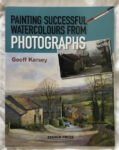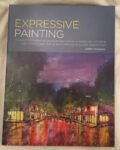I'm struggling to find much to say about this one. It does pretty well exactly…

Painting Trees, Rob and Siân Dudley – Book Review
The latest of my birthday books to be scrutinised is this one by Rob and Siân Dudley. It’s about, guess what, painting trees. It’s a 176 page long paperback and one that feels quite text heavy. It took me a while to get through it.
Contents-wise, we have:
– about 20 pages of introduction
– about 20 pages on materials
– about 15 pages on information gathering
– about 15 pages on designing the painting
– about 100 pages of demos
What’s that add up to? 170, yeah, that’s about right. Let’s talk about those five sections.
The 20 pages of introduction are a gentle warmup for what’s ahead. Lots about why the Dudleys like painting trees, trying to get us excited about what’s to come. Hey ho.
Then we have 20 pages on materials and this is where warning bells started ringing. Because, as well as talking about watercolours, this chapter talks about water soluble oils (whatever they are!), gouache and graphite. I was starting to wonder at this stage whether I’d made a mistake putting this one on the wishlist. If this chapter’s anything to go on and watercolour advice makes up only 25% of the rest of the book, that 25% might be looking a bit expensive.
But before we get on to how to paint in whatever medium, we have a chapter on information gathering. Other books, when talking about this, tend to just tell me to buy a sketchbook and go out doing some simple sketches. That doesn’t really chime with me: even for a sketch in a sketchbook, there’s all sorts of stuff to clear up after painting in watercolour. It’s like those recipe books that talk about simple quick recipes but still generate tons of washing up. There seems little point in saving loads of cooking time if the washing up is still a time drain. Anyway, back to Rob and Siân. I actually found this chapter quite refreshing. They talk about how information can be gathered not just by sketching but also via photos, collecting twigs/berries or even just by staring at something and committing it to memory. And they talk about what makes one different information gathering tactic better than another in different conditions. It shows us how to think!
Then we have the chapter in designing a painting. This is great stuff, and applicable to more than just trees. It’s about a process that starts by thinking about why we want to paint something. This might be to do with light, texture or colour. Then we have to think about what sort of painting would show off that inspirational feature to best effect. Which means we have to think about medium, support, size, orientation, colours, value range and textures. And we need to gather the information we need to create the painting. In all the demos in the rest of the book, Rob and Siân will go through all these steps.
And finally we get to the demos. There are four chapters, devoted to four seasons of the year. Each chapter has a painting of the same beech tree in it, not a demo but a chance for Rob and Siân to lead us gently into the chapter with some seasonal background. And then we get three demos in each season, twelve demos in all. The good news is that nine of those twelve demos are in watercolour, with the other three being in water soluble oils. The water soluble oil demos aren’t there to be skipped either: all the discussion of planning the paintings is valuable to artists painting in any medium, including watercolour. And the demos have given me some ideas about how to maybe use my oil pastels differently.
Which leaves the nine watercolour demos. Wow! Rob and Siân knock the ball out of the park here. In both the planning stage and throughout the painting, they keep telling us why they’re doing what they’re doing. There are even places where one of them with say something like look, the contrast between these dark and light shapes wasn’t as big as I wanted (as discussed in the planning stage) so had to darken this wall (or whatever) but if you don’t have that problem then don’t darken the wall! Authors generally seem to finally be getting the message that we need to hear about the why and not just the how. Another thing I like about these demos is the density of the tips in there. There are so many tips in there that come from experience and that I just can’t imagine any other authors putting to paper. Tips that are genuine tips and not just techniques. Little things dropped in like be careful with this colour as it’s a bit strong, don’t make the wash too wet here because xxx, don’t use opaque colours in your underpainting because yyy, be quick and decisive when putting down shadows. There’s so much useful stuff in there. I think even those readers who want to just copy the authors, work would be happy with these demos. Oh, and those nine watercolour demos are all very different and the authors are careful to bring out within them how the seasons affect choices of colours, value ranges, etc.
At the end of the book I’ve come out feeling like I’m carrying too many ideas in my head to be able to remember without doing some paintings first and then going back and rereading the book again. It’s like going Christmas shopping and trying to make my way back to the car overburdened with stuff and not wanting to drop anything. This one’s definitely a galactico and I’d recommend it to any watercolour landscape artist.
🎨🎨🎨🎨🎨
You can find this book and more reviews of it at Amazon UK here. As an Amazon Associate, I earn commission from qualifying purchases but this costs absolutely nothing extra to you.








Leave a Reply